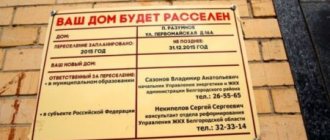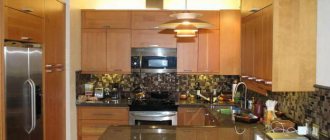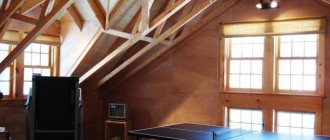According to the legislation of the Russian Federation, in order to convert a premises into residential, the owner of the property must first draw up a technical report on the suitability of the premises for habitation. This document, together with calculations for insolation, heating, ventilation, etc. The condition of the load-bearing structures of the room in which changes are planned is considered.
A technical report on the condition of load-bearing structures is drawn up by a design organization, which is often the author of the building design. In situations where, during the redevelopment of a former non-residential premises, demolition of load-bearing walls is not planned, the design and technical documentation can be carried out by any other organization that has SRO approval.
Repair and construction work is possible after receiving official notification of the transfer of premises from non-residential to residential. This is preceded by stages of approvals in which authorized authorities are involved.
Commission Regulations
The provision was supplemented by paragraph 7 (1), according to which a residential premises or apartment building can be considered unsafe and subject to reconstruction or demolition even if 5 years have not passed from the date of issue of permission to put the apartment building into operation . During these five years allocated by law, the executive body of a constituent entity of the Russian Federation can create a special commission that will assess the condition of the house.
The Commission meets in accordance with clause 7 of the Regulations and consists of representatives:
- the executive body that organizes this commission;
- municipal housing control;
- state control and supervision in the areas of sanitary-epidemiological, fire, industrial, environmental safety;
- consumer protection.
If necessary, employees of architecture and urban planning authorities and experts who have the right to prepare expert opinions are involved.
The owner of a residential premises may participate in the commission with the right of an advisory vote. At the same time, he must be notified in a timely manner about the time and place of the commission meeting.
It happens that one of the commission members turns out to be:
- the person who issued the permit for the construction of an apartment building or for the commissioning of this apartment building;
- representative of state control bodies;
- an official from local government bodies;
- a certified expert who participated in the preparation of documents necessary for issuing permits for the construction of an apartment building or for putting an apartment building into operation.
In such cases, the executive body of the constituent entity of the Russian Federation creates another commission, which does not include the listed persons.
Changes have been made to clause 8 of the Regulations. Previously, the local government could independently decide on the suitability of private residential premises for habitation and send commissions to evaluate these premises. Now this is possible only if there is an application from the owner and the conclusion of the relevant commission.
Changes to the Rules for the maintenance of common property in apartment buildings
117740
Judicial practice of changing the type of residential premises
- home
- /
- News
- /
- General news
From 01/01/2017, relations arising in connection with the implementation on the territory of the Russian Federation of state registration of rights to real estate and transactions with it, subject to state registration in accordance with the legislation of the Russian Federation, state cadastral registration of real estate, subject to such registration in accordance with this Federal Law, as well as the maintenance of the Unified State Register of Real Estate and the provision of information provided for by this Federal Law contained in the Unified State Register of Real Estate is regulated by the Federal Law of July 13, 2015 No. 218-FZ “On State Registration of Real Estate” (hereinafter referred to as the Law on Real Estate Registration).
In accordance with Art. 8 of the Law on Real Estate Registration, the main information that is subject to inclusion in the real estate cadastre in relation to the property is the type of residential premises in accordance with housing legislation.
Thus, by virtue of Article 16 of the Housing Code of the Russian Federation, residential premises include: a residential building, part of a residential building; apartment, part of an apartment; room.
A residential building is recognized as an individually defined building, which consists of rooms, as well as premises for auxiliary use, intended to satisfy citizens' household and other needs related to their residence in such a building.
An apartment is recognized as a structurally separate room in an apartment building, providing direct access to the common areas in such a house and consisting of one or more rooms, as well as auxiliary premises intended to satisfy citizens' household and other needs related to their residence in such a separate apartment. indoors.
A room is recognized as a part of a residential building or apartment intended for use as a place of direct residence of citizens in a residential building or apartment.
At the same time, in accordance with the provisions of the Government of the Russian Federation of January 28, 2006 No. 47 “On approval of the Regulations on the recognition of premises as residential premises, residential premises unsuitable for habitation and an apartment building as unsafe and subject to demolition or reconstruction,” an apartment building is recognized as a set of two or more apartments having independent exits either to a plot of land adjacent to a residential building or to common areas in such a building.
If the registration authority receives an application for cadastral registration in connection with a change in the type of residential premises in accordance with the Law on Registration of Rights, the applicant submits a technical plan.
In 90% of cases, the basis for preparing a technical plan in connection with a change in the type of residential premises is a court decision.
As in 2021, in the first half of 2021, demands were filed in the courts of the Omsk region for:
— recognition of apartments as parts of a residential building;
— recognition of a residential premises as an apartment;
— recognition of apartments as individual residential buildings.
- The greatest interest from the point of view of law enforcement practice is caused by judicial demands for recognition of residential premises as an apartment.
Requirements of current legislation, incl. The above standards stipulate that this type of residential premises such as an apartment can be located exclusively in an apartment building. The requirement to recognize residential premises as apartments is currently relevant for citizens who own so-called “houses for two owners”, for which shared ownership rights are registered.
Thus, when considering claims to recognize residential premises in an individual residential building as apartments, the court, as a rule, orders a forensic examination of the case, within the framework of which the expert resolves questions about the possibility of dividing the house into premises, whether these premises meet the requirements of the Civil and Housing Codes, sanitary and epidemiological rules and regulations of the Russian Federation, whether the use of premises as apartments poses a threat to the life and health of citizens.
Additionally, in the operative part of the court decision, in addition to recognizing the residential premises in the house as apartments, the individual residential building itself must be recognized as an apartment building.
- Recognition of apartments as individual residential buildings is relevant for citizens living in single-apartment buildings and who, upon exercising the right to privatize residential premises, received ownership of the apartment.
This category of cases with the participation of the Branch is most often considered in the Maryanovsky District Court of the Omsk Region. The operative part of the court decision, in addition to recognizing the ownership of an individual residential building, indicates the need to remove the apartment from the state cadastral register.
- In the case of filing claims in court to recognize apartments as parts of a residential building, in the opinion of the Branch, applicants must take into account the following.
State cadastral registration of real estate by virtue of Art. 1 of the Law on Real Estate Registration is carried out in relation to land plots, buildings, structures, premises, parking spaces, objects of unfinished construction, unified real estate complexes, and in cases established by federal law, and other objects that are firmly connected to the land, that is, the movement of which without disproportionate damage to their purpose is impossible.
In this case, information about part of the real estate object is entered into the register of real estate objects only in connection with the established (established) restriction of rights, encumbrance of the real estate object (Article 14 of the Registration Law).
In addition, it is necessary to take into account that by decision of the Supreme Court of the Russian Federation dated 05/09/2015 No. 13-KG15-2, judicial acts of the courts of the Tambov region on recognizing the apartment as part of the house were canceled. The Supreme Court of the Russian Federation indicated the inadmissibility of violating the provisions of the above Art. 16 of the Housing Code of the Russian Federation, Decree of the Government of the Russian Federation dated January 28, 2006 No. 47, as well as the provisions of Art. 36 of the Housing Code of the Russian Federation, which regulates the classification of objects as property of the owners of premises in an apartment building.
The Branch also pointed out these restrictions in a 2016 press release based on Federal Law No. 221-FZ of July 24, 2007 “On Cadastral Activities” (as amended before January 1, 2017).
Created: 05/29/2017 14:02, updated 05/29/2017 14:02
Requirements for residential premises
RF PP N 746 introduced changes to the requirements that residential premises must meet. It concerns the permissible strength values of alternating electric and alternating magnetic fields. Thus, they must correspond to the values established by legislation in the field of ensuring the sanitary and epidemiological well-being of the population.
Otherwise, the requirements remain the same and among them:
- arrangement of living quarters and common property in such a way as to eliminate the possibility of injury when moving;
- installation of engineering systems in residential premises;
- installation and installation of engineering systems in accordance with safety requirements;
- protection of residential premises and common property in apartment buildings from water penetration into them;
- installation of an elevator in an apartment building above the 5th floor.
Profstandart: Specialist in operation and maintenance of MKD
157420
Article 15. Objects of housing rights
1. The objects of housing rights are residential premises.
2. Residential premises are recognized as isolated premises, which are real estate and are suitable for permanent residence of citizens (meet the established sanitary and technical rules and regulations, and other legal requirements (hereinafter referred to as the requirements).
3. The procedure for recognizing premises as residential premises and the requirements that residential premises must meet, including for its adaptation and adaptation of common property in an apartment building taking into account the needs of people with disabilities, are established by the Government of the Russian Federation in accordance with this Code and other federal laws.
4. Residential premises may be declared unfit for habitation on the grounds and in the manner established by the Government of the Russian Federation.
This is important to know: Privatization of a summer cottage in a gardening partnership in 2021
5. The total area of a residential premises consists of the sum of the area of all parts of such premises, including the area of auxiliary premises intended to satisfy citizens’ household and other needs related to their residence in residential premises, with the exception of balconies, loggias, verandas and terraces.
The procedure for recognizing an apartment building as an emergency
pp. 46, 47 and 51 of the Regulations have also undergone changes: additions have been made regarding the return of the application by the commission without considering it and explaining what to do in a situation where the house is recognized as unsafe and subject to demolition or reconstruction.
The commission has 30 days from the date of registration to consider the application or conclusion of the state control body. At the end of this period, the commission makes one of the following decisions:
- recognizes the premises as suitable for habitation;
- notes that the premises are in need of major repairs, reconstruction or redevelopment;
- indicates the premises are unsuitable for habitation;
- recognizes the apartment building as unsafe and subject to reconstruction;
- decides that the apartment building is in disrepair and must be demolished;
- establishes the need for additional inspection of the premises.
RF PP N 746 added one more note. If the applicant has not provided the necessary documents (extract from the Unified State Register, technical passport or technical plan, conclusion of the technical supervision body) and they cannot be requested, then the commission returns the application and relevant documents without consideration within 15 days from the date of expiration of the established thirty-day period.
If the commission recognizes the apartment building as unsafe and subject to demolition or reconstruction within 5 years from the date of issue of permission to put it into operation, and this is not related to natural disasters, then its decision is sent to the prosecutor’s office no later than 5 days later. Deciding whether to take further measures is the responsibility of the prosecutor's office.
If you have any questions, you can always contact us for advice. We also help management companies comply with 731 RF Regulations on the Information Disclosure Standard (filling out the Housing and Communal Services Reform , management company website, information stands) and Federal Law No. 209 ( filling out the Housing and Communal Services GIS ). We are always happy to help you!
Standards for declaring residential premises unfit for habitation. Reference
1. The presence of identified harmful factors in the human environment that do not allow ensuring the safety of life and health of citizens due to: deterioration due to physical wear and tear during the operation of the building as a whole or its individual parts, leading to a decrease in the building’s reliability and strength to an unacceptable level and stability of building structures and foundations; changes in the environment and microclimate parameters of a residential premises, which do not allow compliance with the necessary sanitary and epidemiological requirements and hygienic standards in terms of the content of chemical and biological substances potentially hazardous to humans, atmospheric air quality, background radiation levels and physical factors of the presence of sources of noise, vibration, electromagnetic fields.
2. Residential premises located in prefabricated, brick and stone houses, as well as in wooden houses and houses made from local materials, with deformations of foundations, walls, load-bearing structures and a significant degree of biological damage to elements of wooden structures, which indicate the exhaustion of load-bearing capacity and danger collapse.
3. Residential premises located in residential buildings located in areas where sanitary and epidemiological safety indicators are exceeded in terms of physical factors (noise, vibration, electromagnetic and ionizing radiation), concentrations of chemical and biological substances in the atmospheric air and soil (nitric oxide , ammonia, acetaldehyde, benzene, butyl acetate, distylamine, 1,2-dichloroethane, xylene, mercury, lead and its inorganic compounds, hydrogen sulfide, styrene, toluene, carbon monoxide, phenol, formaldehyde, dimethyl phthalate, ethyl acetate and ethylbenzene), as well as residential buildings located in industrial zones, areas of engineering and transport infrastructure and in sanitary protection zones should be considered unsuitable for living in cases where engineering and design solutions cannot minimize risk criteria to an acceptable level.
4. Residential premises located in dangerous zones of landslides, mudflows, snow avalanches, as well as in areas that are annually inundated with flood waters and in which it is impossible to prevent flooding of the territory using engineering and design solutions. Apartment buildings located in these zones are recognized as unsafe and subject to demolition or reconstruction.
5. Residential premises located in the zone of probable destruction during man-made accidents determined by the authorized federal executive body, if it is impossible to prevent the destruction of residential premises with the help of engineering and design solutions. Apartment buildings located in these zones are recognized as unsafe and subject to demolition or reconstruction. The zone of probable destruction in the event of man-made accidents is understood as the territory within the boundaries of which there are residential premises and apartment buildings that are at risk of destruction due to a man-made accident.
6. Residential premises located in areas adjacent to overhead AC power lines and other objects that create an electric field strength of an industrial frequency of 50 Hz of more than 1 kV/m at a height of 1.8 m from the surface of the earth and an induction of a magnetic field of an industrial frequency of 50 Hz more than 50 µT.
7. Residential premises located in apartment buildings that were damaged as a result of explosions, accidents, fires, earthquakes, uneven soil subsidence, as well as as a result of other complex geological phenomena, are considered unsuitable for living if restoration work is technically impossible or economically infeasible and The technical condition of these houses and building structures is characterized by a decrease in load-bearing capacity and operational characteristics, which pose a danger to the occupancy of people and the safety of engineering equipment. These apartment buildings are considered unsafe and subject to demolition.
8. Rooms with windows facing highways with a noise level above the maximum permissible standard (55 dB during the day, 45 dB at night) are considered unsuitable for living if, with the help of engineering and design solutions, it is impossible to reduce the noise level to an acceptable value .
9. Residential premises, above or adjacent to which there is a device for flushing and cleaning the garbage chute.
The following cannot serve as a basis for declaring a residential premises unfit for habitation:
1. Lack of a centralized sewerage system and hot water supply in one- and two-story residential buildings.
2. The absence in a residential building of more than 5 floors of an elevator and a garbage chute, if this residential building, due to physical wear and tear, is in a limited working condition and is not subject to major repairs and reconstruction.
3. Non-compliance of the space-planning solution of residential premises and their location with the minimum area of rooms and auxiliary premises of the apartment in an operating residential building, designed and built according to previously valid regulatory documentation, with currently adopted space-planning decisions, if this solution satisfies the ergonomic requirements in terms of placement of the necessary set of furniture and functional equipment.
The Housing Code of the Russian Federation in Article 32 regulates the following procedure for the seizure of residential premises from the owner:
1. Residential premises may be seized from the owner through redemption in connection with the seizure of the corresponding land plot for state or municipal needs. The purchase of part of a residential premises is permitted only with the consent of the owner. Depending on for whose needs the land plot is seized, the purchase of residential premises is carried out by the Russian Federation, the relevant constituent entity of the Russian Federation or a municipal entity.
2. The decision to seize residential premises is made by a state authority or local government body. 3. The decision of a state authority or local government to seize residential premises is subject to state registration.
4. The owner of a residential premises, no later than a year before the upcoming seizure of this premises, must be notified in writing about the decision made to seize the residential premises belonging to him, about the date of state registration of such a decision by the body that made the decision on seizure. The purchase of residential premises before the expiration of a year from the date the owner receives such notice is permitted only with the consent of the owner.
5. The owner of a residential premises subject to seizure, from the moment of state registration of the decision to seize this premises until an agreement is reached or a court decision is made to purchase the residential premises, may own, use and dispose of it at his own discretion and make the necessary expenses to ensure the use of the residential premises in accordance with with its purpose. The owner bears the risk of attributing to him, when determining the redemption price of the residential premises, costs and losses associated with investments made during the specified period, which significantly increase the cost of the seized residential premises.
6. The redemption price of residential premises, terms and other conditions of redemption are determined by agreement with the owner of the residential premises.
7. When determining the redemption price of a residential premises, it includes the market value of the residential premises, as well as all losses caused to the owner of the residential premises by its withdrawal, including losses that he incurs in connection with a change of place of residence, temporary use of another residential premises before acquiring ownership another residential premises, moving, searching for another residential premises to acquire ownership of it, registering ownership of another residential premises, early termination of one’s obligations to third parties, including lost profits.
8. By agreement with the owner of the residential premises, he may be provided with another residential premises in exchange for the seized residential premises, with its value included in the redemption price.
9. If the owner of the residential premises does not agree with the decision to repossess the residential premises or an agreement has not been reached with him on the redemption price of the residential premises or other conditions for its redemption, the state authority or local government body that made such a decision may file a claim in court for redemption living space. A claim for the repurchase of residential premises may be brought within two years from the date of sending the owner of the residential premises a notice of seizure of the residential premises.
10. Recognition of an apartment building as unsafe and subject to demolition or reconstruction is the basis for presenting a requirement to the owners of premises in the specified building for its demolition or reconstruction within a reasonable time. If these owners do not carry out the demolition or reconstruction of the specified house within the established period, the land plot on which the specified house is located is subject to seizure for municipal needs and, accordingly, each residential premises in the specified house is subject to seizure, with the exception of residential premises owned by right property to the municipality.
11. If, in relation to the territory on which an apartment building is located, recognized as unsafe and subject to demolition or reconstruction, a decision is made to develop the built-up area in accordance with the legislation of the Russian Federation on urban planning, the body that made the decision to recognize such a house as unsafe is obliged present to the owners of the premises in the specified house a requirement for its demolition or reconstruction and set a period of at least six months for filing an application for permission to build, demolish or reconstruct the specified house. If the owner or owners of an apartment building do not submit an application for permission to build, demolish or reconstruct such a house within the established period, the land plot on which the said house is located and the residential premises in the said house are subject to seizure for municipal needs.
12. Confiscation of the land plot on which an apartment building is located, recognized as unsafe and subject to demolition or reconstruction, and residential premises in such a house before the expiration of the period specified in paragraph 11, is permitted only with the consent of the owner.
The current version of the Moscow City Law of May 31, 2006 “On ensuring the housing rights of citizens during the relocation and vacancy of residential premises (residential buildings) in the city of Moscow” contains the following provisions regarding the relocation of owners of residential premises:
1. Owners who vacate residential premises (residential buildings), at their choice, are provided with equivalent compensation (compensation) or a redemption price in cash or in kind. The amount of compensation (compensation) or redemption price is determined by agreement of the parties based on an independent assessment.
2. The amount of monetary compensation (compensation) to the owner must correspond to the size of the market value of the vacated residential premises.
Monetary compensation (compensation) to the owner is provided in non-cash form and is used for the acquisition of residential premises or for other purposes if the owner has another residential premises in respect of which the owner has the right of use or right of ownership. Compensation (compensation) in kind is provided to the owner in the form of another comfortable residential premises by concluding an exchange agreement or another agreement defining the transfer of ownership of residential premises.
The cost of residential premises provided as compensation in kind must correspond to the market value of the vacated residential premises, except in cases specified by law.
3. When determining the redemption price of a residential premises (residential building) seized from the owner in connection with the seizure of a land plot, it shall include the size of the market value of the vacated residential premises (residential building), as well as all losses caused to the owner in connection with its seizure, compensation for which provided for by federal legislation when seizing residential premises. By agreement with the owner of the residential premises, he may be provided with another residential premises in exchange for the seized residential premises, with its value included in the redemption price.
4. With the consent of the owner, an exchange agreement may be concluded with him, according to which the owner is provided with another comfortable residential premises equivalent to the vacated residential premises. In this case, an equivalent residential premises is recognized as a residential premises, the area of which is not less than the area of the vacated residential premises, and the number of rooms corresponds to the number of rooms in the vacated residential premises. In this case, there is no additional payment for the difference in the prices of the exchanged residential premises.





